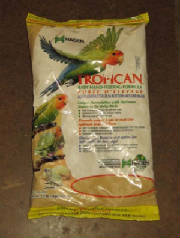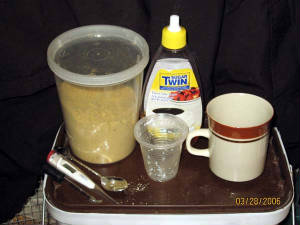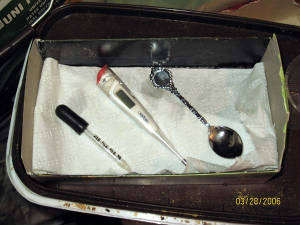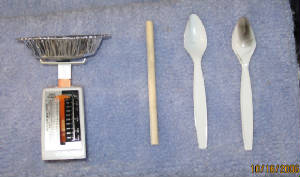|
Handfeeding
You have a clutch of 4 wriggling aliens and Mom and dad refuse to sit on and feed the babies. AAAK! What do you do?! This
page will (hopefully) help you out with this very easy, but easily messed up procedure. The act of handfeeding is simple,
but many things can go wrong if precautions are not taken.
Return to Breeder Basics
Tropican is one of the many handfeeding formulas on the market. All handfeeding formulas I have encountered have been a powder
that you add to hot water, mix and wait to swell. They're very easy to use and are much superior to anything home made.
The above images are of handfeeding supplies I use. I find the three most important tools I have are 1) paper towels, 2) a
digital themometer - waterproof if you can find one! and 3) Disposable cups in which to mix formula.
The other tools I use include an eyedropper, plastic measuring spoon with the edge wwiddled away so the babies can feed
form it easier, a small spoon for measuring formula and an old mug that I keep the mixed formula cup in. When the formula
is mixed in the disposible cup, I place it in the mug that is filled 1/4 way with hot water. That helps keep the formula warm.
Other useful items include a small box to put all the handfeeding supplies, a few rolls of toilet paper and a letter scale
that measure in grams. I recently bought a cheap scale that reads in both grams and OZ. I glued small velcro patches on the
bottom of a metal tart cup and the scale top so the very young babies won't fall off the scale as I measure them. You would
use the scale to measure the babies before each feeding. That helps keep track of the chicks' weights and any deviations would
warn of illnesses. I find I can tell by feeling the chicks' keels. If it gets too prominant, I know to feed them more. The
scale helps verifiy what I'm doing.
Something new to my collection of handfeeding supplies are plastic spoons that are melted to bend the sides up. I am physically
incapable of bending the sides up on a metal spoon, so I was forced to find a decent alternative. The result was a package
of plastic spoons, a lighter, a short wooden dowel and 1/2 an hour of pyromania, LOL! The plastic spoons were easy to bend.
I lit the bottoms with the lighter, gently shaped the spoon sides up with a wooden dowel and I dipped the results into a cold
glass of water for cooling. It's important to do this shaping outside as the plastic makes a LOT of smell. The result you
get is a decent handfeeding spoon that is not only disposible but you can reuse them if you wish. The one problem I had with
the shaping was that some spoons would form a vertical crack on the inside. I figure you could still use these for handfeeding
but toss them out after a single feeding as the cracks can harbor bacteria. After shaping I washed each spoon off with hot
water and antibacterial soap. The lighter leaves a nice black patch on the bottom (as seen in the photos) but it shouldn't
be of any concern if you wash it off good. I have about six of these spoons at hand plus extra unbended spoons if I need
extras.
There's several things you will need to buy in bulk, no matter what. Paper towels are the big item. I go through a package
of eight in two weeks. Times that by the number of feedings and two months and you'll need about four or five packages like
that. The same with handfeeding formula. Purchase two or three bags of the stuff and keep them in the freezer. Tropican Handfeeding
Formula doesn't have to be refridgerated when open, so I keep out a plastic container full of formula and I put it near the
babies and feeding supplies. Freezing the formula leftovers extends the freshness and keeps the formula from developing mold
if it is kept out for too long. Generally formula lasts a good year unopened. If you won't be handfeeding and you've got extra
formula, offer it to a bird club. There's bound to be someone desperate for the stuff!
Feeding cockatiels on a regular basis is very important, as is mixing the formula right. Below are the facts you'll be needing
when feeding Cockatiels and Conures. I've based my schedual and instructions on those given on the package of LM Animal Farm's
Neo-Nate formula and Cockatiel Cottage
http://www.cockatiel.org/articles/handfeeding.html
|
1 to 4 days
|
Feed every 2 hours around the clock, day and night. Chicks should be fed 6-10 times daily.
|
1-2 CCs (One CC is aproximately one Millilitre)
|
|
|
5 to 7 days
|
Feed every 2-3 hours from 5 am to midnight. Feedings after Midnight to 5 am may be eliminated.
|
2-3 CC
|
|
|
8 to 14 days
|
Feed every 4 hours from 5 am to midnight.
|
4-6 cc
|
|
|
15 to 24 days
|
Feed every 5 hours from 5 am to midnight.
|
7-10 CC
|
|
|
25 to 34 days
|
Feed at 7 am, 5 pm, 11 pm . Last feeding can be given between 10 pm and Midnight. First feeding should be given between 6
and 7 am.
|
11-15 CC
|
|
|
35 to 44 days
|
Feed twice a day - generally between 7 am and 7 pm. Introduce seeds and adult foods at this time to encourage babies to forage
on their own.
|
11-15 CC
|
|
|
45 days to weaning ( Aproximately 12 weeks for conures, 8 weeks for cockatiels)
|
Feed once a day at 7 pm. To incourage babies to eat on their own, place a mentor bird in the cage with the babies and put
food on a plate to encourage the chicks to eat.
|
11-15 CC
|
|
|
ALWAYS USE THE THEMOMETER TO TEST FORMULA TEMPERATURE!!!!!!! Heat the formula by using Hot water and stir until it cools to
the correct temperature. To keep the temperature consistant while feeding, put the formula cup in a mug 1/4 full of hot water.
Formula must be between 100 F and 108 F (38 C - 42 C ). It's at the ideal temp when between 104 and 107 F (40 C - 41 C).
It should NEVER ever ever be hotter than 108 as it can cause burns and severe problems with the crop. Many people don't realize
how important this is, thus my emphasis.
If you use a microwave to heat formula, **ALWAYS** stir well to rid the formula of hot spots. I stir it for a good 30
seconds, and when heating in the microwave I heat the formula in 7 second spurts to prevent cooking.
When a chick is 1-4 days old, the formula should be rather thin, like a soup. From 5- 14 days, the formula should be like
a thicker soup, then increased to the consistancy of a thin pudding from 14 days on.
|
|
NEVER RE-USE OLD FORMULA! This encourages bacterial growth which is a major problem in a chick.
|
|
When the babies start to feather out, you can put them in a low cage with low perches. They're starting to use their feet
at this stage and will grip everything. I stick a small but wide 'trainer' perch in the brooder at this stage. I also put
a small toy that they can peck at. Some breeders start offering food at this point. Expect a lot of waste at this stage, as
the babies still don't know how to eat themselves and will mainly play/poop on the stuff offered.
|
|
Once the babies are capable of perching, you can start putting in a low container of water in the cage. I also offer a bit
of what they'll be eating when they're weaned on the bottom of the cage. They may not eat it, but they'll show enough curiosity
to mouth it and learn the texture.
|
|
As the babies Age, you can add more perches. When they hit the five week mark, I let the birds test their wings by gently
tossing them onto my bed or a well padded floor. Don't toss them too far, too high or too hard. I generally toss them only
a foot into the air on my bed. They're starting to learn what their wings are for and they will sometimes take off like they've
done it their whole lives. I've been plesantly suprised by their flying ability. Landing however, is a bit of a challange.
Expect some thumping into walls and floors at this stage. It's important to let the babies learn how to fly, as it increases
their confidence and they become better adjusted as adults than if they never learned how to fly. I let them use their wings
for 2-3 weeks then gradually trim their wings over a few days.
|
As I mentioned before, Handfeeding is a relatively simple procedure, but when done lazily or without a watchful eye, many
things can go wrong. This page at Cockatiel Cottage has a wonderful list of problems one can experience while handfeeding:
http://www.cockatielcottage.net/feeding.html
Below is another link, found at Winged Wisdom, regarding treatment of some problems a breeder will encounter while handfeeding.
I find that I can prevent many problems by using paper towel on the bottom of the brooder, adding a few drops of apple cider
vinegar to the formula and if a chick has a mild case of slow crop (usually due to chilling) I steep some Echinacea tea and
offer the chick a few drops of the warm fluid. I then massage the empty crop to break up any formula that may be stuck in
it.
http://www.birdsnways.com/wisdom/ww63e.htm
Below is a link to a video file I made of me handfeeding a baby cockatiel. My hand positioning is wrong because I was filming
and feeding at the same time, but otherwise it is a good example of feeding a baby by spoon. To Download the file, just hit
the 'Download to desktop' option beneith the file icon :-) .
Handfeeding By spoon (LARGE FILE! 16 MB!)
|





